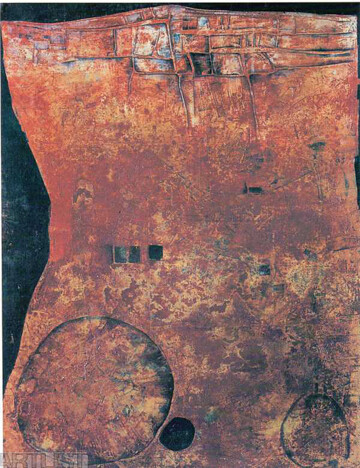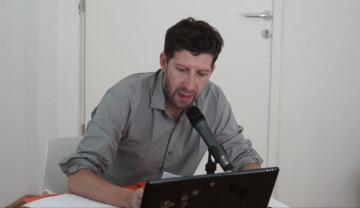Conceptual art as an intuitive choice. Postmodernism and post-conceptual art in Czechoslovakia
… je vous l’ai déjà un peu introduit, la dernière fois,
par cette remarque qu’il était tout à fait impossible
de penser quoi que ce soit qui tienne debout sur la bipartition logique
et mathématique, si difficile, si problématique pour les mathématiciens.
Est-ce que tout peut être réductible à la logique pure? c’est-à-dire à un
discours qui se soutient d’une structure bien déterminée. Est-ce qu’il
n’y a pas un élément absolument essentiel qui reste, quoi que nous
fassions pour l’enserrer de cette structure, et pour le réduire? un dernier
noyau, tout de même, qui reste et qu’on appelle intuition.[1]
1. Postmodern ideas found their most diverse application in the field of architecture and architectural theory. This was the case also in Prague at the beginning of the 1980s, in the thought of the theoreticians Jana Ševčíková and her husband Jiří Ševčík[2]. Their programmatic texts, following on from Venturi, Jencks, as well as Norbert-Schulz, proclaimed the demise of the hegemony of the international style, the form of which in socialist Czechoslovakia was rather closer to the old avant-garde idea of architecture as machines for living. Postmodernism demarcated a space for theorising in contemporary art, and provided ground for an understanding of architectural creativity as symbolic production. Postmodern ideas were applied also in the fine arts, to where the focus of → interest and organisational activity of the aforementioned Ševčík couple shifted in the second half of the 1980s.
In Prague, during the period of postmodernism and trans-avant-garde (approximately in the period of 1985-1994), reading of the Old Testament, mythological tales, texts and passages became popular. The discovery of Beuys, Cucci and Paladino gave new life also to Freudian psychoanalysis, which presented an academically acceptable reason for fascination by forgotten narratives and displaced rituals. Beuys’s political engagement during this period had no discernible significance, his works were revered as relics and his personal appeal was that of the allure of a pagan priest. The vernacular symbolistic ground of postmodernism was closely linked with the inspirational sources of “imaginative” → tendencies – surrealism, post-surrealism, informalism, figurative painting and similar currents, which occupied a privileged position in the Czechoslovak cultural tradition of the 20th century. Despite this, from the very first moments, the protagonists of postmodernism, immediately found themselves in direct conflict with them. The cause of the conflict could be described in simplified terms as a dispute concerning the status of the symbol, metaphor or signifier.

Figure 1: Mikuláš Medek, Red Venuse, 1959, oil, pasteboard, 93.5 x 73 cm, Gema art.
For the imaginative tendencies, the symbol was a pretext of the author’s journey into the self – the reality or perception of the reality was internalised by the → subject in order to enable the imagination and subconscious to produce symbolically (the internal model). The author could also transcend beyond the self into a “symbolic space”. Within this connection it is interesting to recall the work of Mikuláš Medek, an author who during the 1950s revelled in magical realism, focusing on a hyper-realistic identification of the internal model, so as later, under the influence of abstract expressionism and Art informel, to arrive at a theory of the image as a tangible imprint. (Figure 1) Even despite the declared processuality and materiality of the imprint[3] in such images, the author continually returned in their titles and completed forms to an insertion of the imprint into existing spiritual iconographies. “To create a precise image without the use of illusions, deceptions and various magic tricks and lies is impossible”.
In contrast with this, Jana and Jiří Ševčík approached symbols as they did signifiers, whose meaning is not determined by any transcendence, but by syntactical constellations and the practice of their reading, which is constructed by the reader.
2. Postmodernism declared an opening of histories, styles and epochs on the principle of equality – within its realm, the avant-garde canon of beauty was not the unique one, as is the case in modernism, but the almost limitless historical sum of cultural production offered a stockpile of aesthetically equal elements. Nevertheless, during this period painters and sculptors had to follow their own “cultural-anthropological” preferences. They were interested in apocryphal (rather than canonical) tales, ephemeral civilisations of nomads (rather than classical periods) who left only minimal material traces behind them. This poetics indicates the need to construct narratives and landscapes beyond the boundaries of existing historicities – in periods which, due to the lack of material sources, are neglected by the traditional historical sciences. This view found an unexpected resonance in Eastern Europe.
The Czechoslovak cultural environment (and also other East European countries) that had suffered from the physical and intellectual isolation of the Iron Curtain had been asking the question, with increasing anxiety, as to whether it continued to be a part of history whatsoever. Trepidation concerning the “nihilisation of history” was well articulated by Ivan Klíma in the historic moment of the Prague Spring (1967–1969). This period was ushered in by the 4th Congress of the Union of Czechoslovak Writers, held in June 1967. On the floor of the congress of writers and literary theorists, critical rebukes of censorship and other authoritarian practices of the socialist regime were expressed in public. Klíma’s contribution, among other factors, dealt with the relationship to one’s own history: “The loss of awareness of historical continuity, the loss of recognition and reverence for individual historical epochs, leads to disastrous consequences... Without the awareness of continuity man has a nihilistic relationship toward all that is past... Such a person is transformed into an uneducated barbarian, and acts with barbarian coarseness also in his everyday life. The nihilisation of certain epochs and distinguished personages has dire consequences, especially in the nurturing of the younger generation, which due to the moralising primitivism of prescribed sets of values loses all sense of value”. This appeal above all related to a criticism of the bureaucratic politicisation of general and cultural history that was taking place in state-controlled schools, in universities and scientific institutions. As a result of genuine, but frequently rather ritually staged fears of historical revisionism, certain movements and figures of history were ignored.
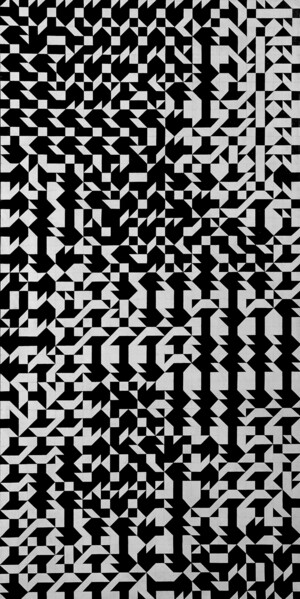
Figure 2: Zdeněk Sýkora, Black and White Structure, 1966–1967, oil on canvas, 220 x 110 cm. City Gallery Prague.
During the Prague Spring, thanks to the opening up of discussion and borders, the work of one generation[4] of visual artists was partially integrated into the exhibition, critical and commercial operation of the West (and therefore into its history), and became partially internationalised[5]. (Figure 2) The suspension of the circulation of persons and artistic artefacts (tangible from 1970 onwards) once again restored the briefly suspended absence. The dispute concerning the nihilisation of history, in which polemics were physically displaced from the public space, conducted in private seminars in flats, was transformed into a fear as to whether a society of “torpidity” had any history whatsoever. This fear was sparked both by the renewed absence of Czechoslovakia in the history of the West, and also by the ritualised vacuity of expressions in the public arena (a celebrated example here is provided by the greengrocer from Václav Havel’s essay “The Power of the Powerless”).
The potentiality to build a new socialist, communist history was not on the order of the day, disallowed by the authoritarian control of intellectual production by state bureaucratic supervision. Only isolated figures of dissent (Egon Bondy) formulated a critique of the authoritarian regime from left positions. By adopting such a stance, they found themselves in a position of double outcasts – Bondy was a part of the dissent in opposition, persecuted by authoritarian power, and within the framework of this community represented a philosophical, ideologically contradictory minority.
3. The postmodern turn, opening the door to a past outside of history, was received with enthusiasm in Prague, because it offered artists a pre-historical past as a reservoir of fragments of an epoch in which actors (regardless of academic history) could be equal on both sides of the Iron Curtain. The return to prehistory brought with it the effects of a heavily painkilling drug, which explains the abundance of use and popularity that it began to enjoy.
Kafka was once again read, understood as a radical social nihilist offering the “powerless” a last chance, which was artistic creation. In addition to the Italian trans-avant-garde, fashionable figures included Josef Váchal and Ladislav Klíma, and people read Eliade, Bataille, Burroughs and Castaneda. They were able to listen to the previously censored band Plastic People, whose lyrics included the semi-ironic refrain from a poem by Egon Bondy, which was now understood without ironic distance: “My žijeme v Praze, to je tam / kde se jednou zjeví Duch sám” (“We live in Prague, in this city here / the Holy Spirit will one day appear”).
A direct confrontation of the mystical tradition of postmodernism on the domestic scene took place on a number of levels around the period of 1997–2000. Its initiators, Jana and Jiří Ševčík, renounced the overused term and retained its intellectually ornamental language, by which they described indistinct and fleeting signifiers proliferating on the exterior of reality. They drew attention to the fact that the sense of the postmodern turn was not an ahistorical or limitless relativisation of values, but the principle, denied by modernity, of difference and differentiation of aesthetic forms. Cultural differentiation, which had its autonomous historical reasons in the field of art, quickly became the official cultural programme of “democratisation” of society after 1989. For a long time we had believed that democracy and capitalism were two separate processes, and that aesthetic differentiation was a mirror image of the → emancipation of civil society.
At this time, more or less for intuitive reasons, I began to engage in a review of Czechoslovak art and its international relationships in the 1960s. The work, originally motivated by fulfilment of university obligations, gradually began to acquire a very topical connection with the works of artists of the upcoming post-conceptual generation. A reading of the texts of periodicals from the 1960s – Výtvarného umění, Výtvarné práce and the catalogues placed before us – and opened up a long-lost polarisation through which Czechoslovak art had passed during this period. This was a division into imaginative → tendencies and constructive tendencies, which included above all concrete painting, programmed art, variables, etc. A transitory position was occupied by experimental poetry. Through the methods used by Josef Hiršal, Bohumila Groegerová, Jiří Kolář, Jiří Valoch and others it adhered to constructivism, its materials were language and speech (visible and audible). Beyond the boundaries of these movements there stood – without a clear distinction or definition of the movement of conceptual art, performance art, happenings, Fluxus (the background of which was broached only sketchily at the end of the 1960s in articles by Jindřich Chalupecký, Jaroslav Kořán, Karel Miler, Tomáš Štrauss, Josef Kroutvor and others).
The task, which faced the movement of post-conceptual art in the period of 1995–2008, could be formulated as a need to situate desires within a communicable and shared conception of history. The motivation was not scientific; it was an intuitive response to a persistent fear of ahistoricity, which could not be overcome by subjective transcendence. The ahistorical point of return offered by postmodernism had now ceased to be functional. This does not mean to deny that a long list of curators and artists continued within this current, but that it neglected to answer questions which at that time were being posed by the West: What happened in Eastern Europe during the period of isolation behind the Iron Curtain, and who, and through what programme, will constitute the “new” world following the fall of ideological binarity?
Some newly established institutions[6] and artists responded quickly by an appropriation of themes from the current Western discourse – exhibitions were held engaging with public art and the status of the work of art within a public space[7], New Technologies, a magazine issue devoted to women’s art, body politics was thematised, discussions were held on the themes of East and West, centre and periphery, and so on. The tactic of appropriation, despite its immediate usability, had one weakness – it neglected the inclusion of historical experiences and practices of East European art into the historical canon which originated within the context of works of Western art, in which, if this canon is not to be rewritten, vernacular works will always be judged according to the logic of “ethnographic artefact”[8] or “visual similarity” as secondary derivatives. For this reason, we focused primarily on the first question and investigated whether at the present moment we could find works and artistic practices of a hybrid nature – which are recorded in the movement of the international avantgarde, and herein thematise the conditions of life under real socialism.
We may explain the obsession with → reconstructions of vernacular histories in post-communist countries and the immense reception of the archive and documentary turn in this geographical space only by means of the potency of the fear of being ahistorical, that may acquire the solid ground of physical science of being outside of the event horizon[9]. This fear had a far stronger effect than the influence of Benjamin or Foucault’s texts. Their reading and contemplation requires time, which was not then available. And if we identify with the formulation of intuitive decision-making as an immediate insight into a problem, which is not of a rational nature, then the search for works of art and personalities, which fulfil the need for the aforementioned binarity, was of a purely intuitive character.
Here we must remind ourselves of one further dichotomy, which is well illustrated by the difference between “bricolage” and the work of an engineer, as described by Claude Lévi-Strauss In the post-communist period, methods of work, intimate customs, physical practices, but also emotional experiences and life values from the era of “real socialism”, were brought before a strict court. The habitus of the real socialist subject was first of all within the environment of the capitalist organisation of work and its libidinal economy declared as a dangerous anachronism. Together with the outworn machines from the socialist factories, the outmoded forms of working and living that collided with the practice of the new capitalist man had to be eradicated. The eradication proceeded by means of bureaucracy – a method that was intrinsic to the opposing orders on both sides of the Iron Curtain. As David Graber notes, the instrumental rationality of bureaucracy penetrates across ideological orders, and its ideological neutrality explains why the bureaucratic elites of real socialism managed without difficulty to adapt to the capitalist organisation of production.
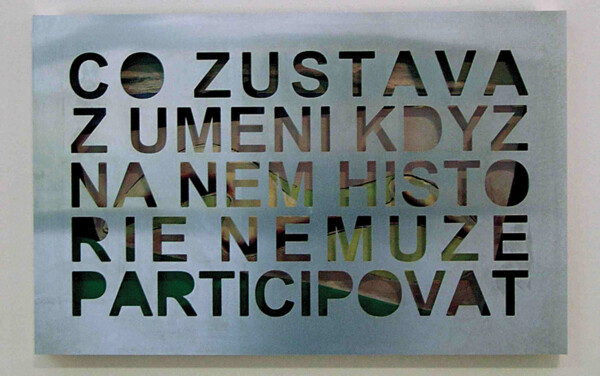
Figure 3: Ján Mančuška, ...and Back Again (What rests from Art if History cannot Participate on it), 2004, aluminium plate with cut out text and painting of Frantisek Muzika, Figure in Landscape, 1932. Photo: Moravian Gallery Brno.
The condemned habitus of the socialist subject in the post-communist period could not be defended directly, but this took place indirectly and partially, by means of a “bricolage” of old practices with new ones. The popularity of DIY and various forms of bricolage was motivated by a tactical conciliation of the old habitus with the requirements of the new paradigm, and explains the hand-crafted and impure forms of post-conceptual practices in Eastern Europe (Pawel Althamer, Roman Ondák, Jan Mančuška, Marjetica Potrč), which accompanied the reprogramming of the Kafkaesque victim as a democratic citizen and motivated employee. (Figure 3)
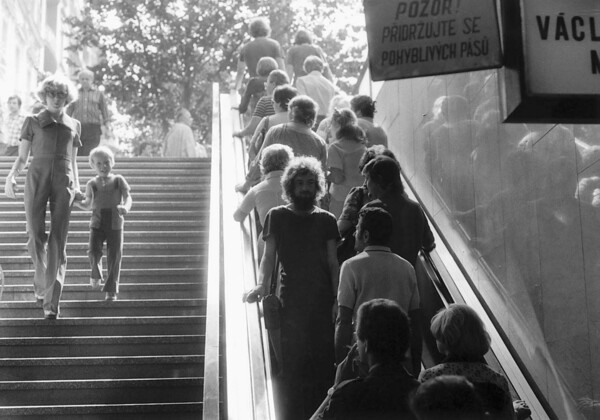
Figure 4: Jiří Kovanda, Untitled (On an escalator ... turning around, I look into the eyes of the person standing behind me ...) (3 September 1977), 1977, photographic documentation of an action.
4. Marina Abramovic, Stanislav Filko, Oskar Hansen, Sanja Ivekovic, Július Koller, Jiří Kovanda, Mladen Stilinović, Goran Trbuljak … (Figure 4) for the first generation of East European post-conceptual artists these models were an intuitive choice, because they fulfilled their own vision of the future – they were a part of the international neo-avant-garde movement, in which their works had their own agenda, which was not a mere weak derivative of Western conceptualism, but differed in its nature.
Western and Eastern conceptualism had one common starting point, which was tautology. Clement Greenberg asserted in his influential exegesis that American abstract expressionism came closest to the sense of artistic creativity in that it found the chief function of painting, which was truthfulness, in the two-dimensional nature of the canvas stretched on the frame and the physical properties of colour. The sense of creativity was to give vent to the possibilities of the devices of painting without the author having to engage with a fantasy or imaginary word, or referring to how reality appears to human perception. Minimalism theoretically and practically purged art from the residues of “European composition” and replaced it with a “sequence of one thing after another”, but conceptual artists returned for contemplation of Greenberg’s thesis twenty years later, when the hung picture and the sculpture were now considered an anachronism.
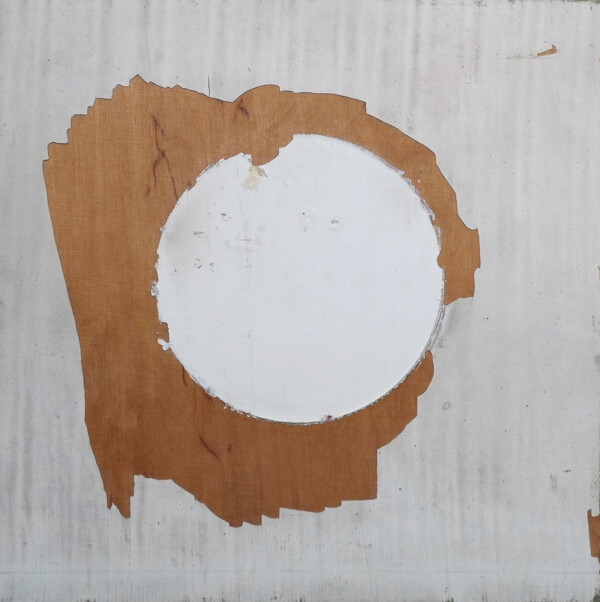
Figure 5: Július Koller, (Subjectobject), 1968, latex, wood, 20.8 x 20.8 cm.
L’air de Paris, Ceci n´est pas une pipe, the tautology of Lawrence Weiner, three chairs by Joseph Kossuth, the word Neon created from neon tubes, the paintings Sea and Picture by Július Koller... (Figure 5) The enumeration of tautologies could continue for longer. The creation of tautological work metaphorically corresponds to the description of the individual artist under a collective contract, confirming that only a single statement exists, from which the sense of truthful art is derived. Only A=A. Only an identical object, an identical proposition, can meet the condition of truthfulness (in which modern reproductive techniques erased the ontological difference between the original and a copy).
“Works of art are analytic propositions. That is, viewed within their context – as art – they provide no information what-so-ever about any matter of fact. A work of art is a tautology in that it is a presentation of the artist’s intention, that is, he is saying that that particular work of art is art, which means, is a definition of art”.
East European conceptualism (more precisely speaking also European conceptualism, such as Brodthaers) understands tautology in a broader sense than Kossuth’s analytical pronouncement (which is itself a tautology). European and East European conceptualism demonstrates that tautology does not concern only language-based systems, but relates every system of representation to the whole of the world (subject, objects, ideas). An explanation of the problem of conceptual art as a problem of indexicality is thus a partial reduction.
The lack of clarity shrouding the first sentence of Sol Le Witt’s Sentences: “Conceptual artists are mystics rather than rationalists. They leap to conclusions that logic cannot reach”, could be explained precisely by the necessity of a “leap” towards the postulate that only an identical thing is true. Every signifier according to such an understanding of truthfulness refers only to itself, and the starting point of each interpersonal system of communicable and representation is tautology. Conceptual art does not end here, but rather begins. It comes to this point by a direct “leap”, and even if it appears to be uninteresting to admit, its final intention was a current rebuilding of the traditional desire for truthfulness in depiction of reality.
This historical excursion could be concluded with the statement that the demand of post-conceptualism for the integration of the vernacular history of Eastern Europe into the canon and operation of history has been partially fulfilled, and this therefore represents a closed chapter, as could be attested to also by the transformation of post-conceptualism into ornamental, mainstream expression, an acknowledgement of the hypothesis that the surpassing of conceptual and post-conceptual art, as well as the entire spectrum of the movement of the neo-avant-garde, is resisted by one demand, which they outlined and which was not referred to here, since in Eastern Europe it was not articulated systematically until the immediately following period. This is the question of the ideological function of the aesthetic experiment. Post-conceptualism in Eastern Europe, with only a few exceptions, did not identify with the explicit politicisation of art, which it considered “illustrative”. Its actors believed that espousing the conceptual form in itself contained an ideological stance, which is internally critical with regard to the commodification of art, and thus also the market system, and above all on the basis of epistemic truthfulness clearly expresses an ideological alternative of its own stance. “My opinion is that the artistic act as such contains political meaning, that it’s a certain concept of processing the world that is capable of shifting the perception of people and their way of life exactly by means of that which it is – an authentic examination of the world performed with a certain degree of detachment. That’s where its strength and self-confidence lie. And also the possibility of altering people’s thinking in some way with respect to questions of the order of society and power”.[10] Although today we can view conceptualism as a history of commodification, its main demand of truthfulness, which was an intuition formulated as a tautology, cannot remain on the level of an aesthetic function without a response – either from its continuers, or its opponents.

